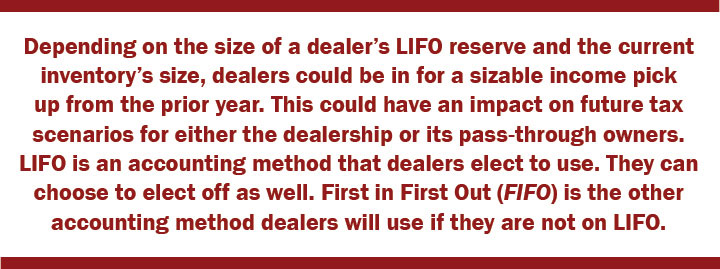By Phil Craft, CPA and Brian Wallace, CPA
Many dealers have struggled to hold on to incoming inventory to meet the market demands with industrywide inventory shortages. With the sales fluctuations for new and used car dealerships, it will pose some problems going into year-end tax planning scenarios for those valuing inventory under the Last In First Out (LIFO) accounting method.
LIFO reserves contain cumulative layers of year-over-year changes in price indexes relating to inflation. In short, it is deferred income. The longer you have been on LIFO, the chances are the greater size of your reserve in relation to your total inventory. It often comes up in transfers of stock and valuations as an adjustment to value (for the deferred liability). Historically, if your inventory remains the same and inflation keeps increasing, the reserve will grow. Each addition to LIFO accumulates a “layer.” Each layer represents the historical capture of these changes in price cost on specific models. It reduces your inventory cost and increases your cost of goods sold if the cost increases and vice versa for the cost decreases. For example, if a new model is added, it starts with an inflation index of one. The next year, the cost of these vehicles’ is adjusted by the price increase (or decrease) put out by manufacturers. A lot of what happens to LIFO reserves has to do with the cost changes and how it relates to inflation, and for this reason, dealers should watch inflation very closely. It would also be wise to look at what your manufacturer is doing. If it is restructuring any given model’s cost, the LIFO index will result in a net income pickup. It is an often extremely complex calculation and requires experts and software to calculate.
There are very few industries, besides automotive, that value their inventory under LIFO, but it tends to be a large number that do. It represents upward of $1 billion of deferred tax revenue. Because of this figure, LIFO always seems to be on the table in congressional tax discussions on raising tax revenue. It also appears to be discussed in tax accounting and lobbying circles across the country. It is a welcome tax deduction for most dealers every year but, like any reserve, will eventually be recaptured. If Congress were to get rid of LIFO, dealers would need to recapture the income, most likely in four years, at higher rates than currently in place (39.6% if reverting to pre-Trump era TCJA and about 29.6% in the current rate structure). As the political landscape changes, it is always possible LIFO will be repealed.
Depending on the size of a dealer’s LIFO reserve and the current inventory’s size, dealers could be in for a sizable income pickup from the prior year. This could have an impact on future tax scenarios for either the dealership or its pass-through owners. LIFO is an accounting method that dealers elect to use. They can choose to elect off as well. First in First Out (FIFO) is the other accounting method dealers will use if they are not on LIFO, although FIFO results in higher-cost inventory and no deductions for price increases on older inventory.

The potential for recapture, combined with expected income pick up associated with PPP loan forgiveness (note that the expenses contributing to the non-taxable forgiveness income are nondeductible, essentially making the forgiveness itself taxable) could combine for a one-two punch that hinders a dealership’s cash flow coming out of the first quarter of 2021.

One planning option would be electing off LIFO. Typically, with an accounting method change, you could elect to take the reserve evenly over four years, reducing your potential tax event in the current year and taking advantage of what remains of some of the more favorable tax years ahead (think QBI). Not only would this apply to New Car LIFO, but it could apply to many other inventory-based tax deferrals, including dealer trade discounts. Whether this approach will work depends on a dealership’s unique tax strategy. It is not a dollar-for-dollar or one-size-fits-all strategy, and, in an adverse planning strategy, it could make sense to take in the recapture this year. Make sure you consult with your dealership tax professionals to ensure a proper LIFO estimate is indexed and all scenarios are addressed. While dealers are coming out of some record-breaking gross profit months, it is still important to keep cash reserves. Good tax planning is key to making sure the cash remains in your dealership.
Dealerships should reach out to their tax advisors to develop a strategy to minimize tax liabilities and hang on to cash.
Phil Craft, CPA, is a Manager in the Retail Automotive Services division of Withum and can be reached at pcraft@withum.com. Brian Wallace, CPA, is a Tax Lead in the Retail Automotive Services division and can be reached at bwallace@withum.com.
This story appears in Issue 4 2020-21 of the New Jersey Auto Retailer Magazine.







